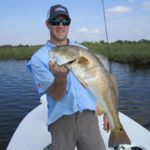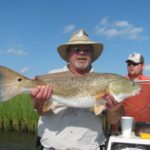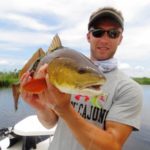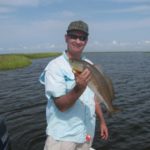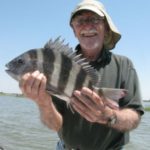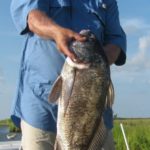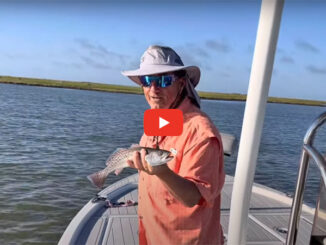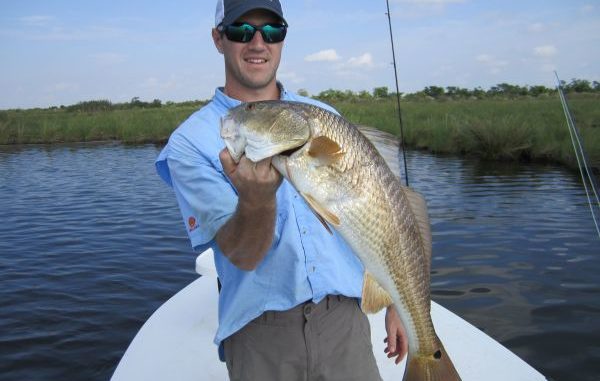
If the teal don’t show up this month, no worries.! Just head to this coastal fishing hamlet for some close-in redfish action — and hear your drag sing.
Pelayo’s scouting report was as bleak as the LDWF’s aerial report. And both destroyed the giddy forecasts from DU and the U.S. Fish and Wildlife folks.
“We didn’t see teal one!” Pelayo snorted while stomping into the “den” of Doc’s new “camp” at Proctor’s Landing.
“Dey probably all scattered!” snapped Artie. “From the super-high waaaw-da! From the super-strong southeast winds we been having. You know how that goes. Shoot man, dat’s a no-brainer! Everybody knows teal like to dabble and hang in shallow waaaw-da! We always see swarms of them in the pastures by Myrtle Grove after floods and storms!”
“I know, I know,” Pelayo nodded disgustedly. “We didn’t expect to find many — but I’m telling ya we didn’t see ANY! … Ya follow what I’m saying?”
“And here all the reports had everybody all pumped for this teal season!” Eddie moaned. “Record-high breeding pairs, blah, blah! Record-high continental populations, blah, blah! So they cranked up the season to three weekends. Cranked up the limit to six teal — and we can’t even find ONE!”
“And tons of grass in this area nowadays,” Eddie added. “I guess from closing the MRGO and river waaaw-da coming in through Violet Canal — man just five years ago you never saw hydrilla growing in this area. Now we got the habitat — but no ducks! Can’t win for losing!”
“And YOU was one of da ones always moaning and groaning about having to close the MRGO!” Artie laughed, while pointing at a suddenly frowning Spencer. “All the erosion, all the damage to the marsh, etc. You was always preaching about dat stuff. Now you’re moaning and groaning about getting out to Da Rocks and Bay Eloi and Da Central and Da Holy Cross through that tricky spoil canal with dangerous boat traffic.
“And you’re also moaning and groaning about how the speck fishing slowed down closer in on count of all the fresh waaw-da! Make up your mind!”
Spencer’s frown tightened. His mouth and eyes narrowed to slits — and everybody noticed.
“And we covered a good chunk of marsh while scouting, believe me,” Pelayo said quickly, eager to defuse the scene. “All the way from Lena Lagoon and across Bayou St. Malo into Bayou Muscelini. Waaaw-da’s high all over. No worries about getting stuck or even churning up any mud in any shallows. Man we just blazed over dat marsh!”
“We only stopped twice, “Eddie added in a jovial tone, and with a big smile. “Two stops, five casts — and we got three beautiful reds to show for it! Man, the marsh is fulla dem!”
“Well, there’s always an upside to all these blustery southeast winds,” Spencer finally answered. “I kinda expected it.”
He looked over at Doc and nodded smugly, finally starting to smile.
“Think we’re forgetting the teal for tomorrow,” Spencer said. “Think we’re going after the redfish.”
A beaming Doc reached over and high-fived Spencer.
“Wasn’t too excited about fighting the heat and mosquitoes in the first place,” Doc laughed. “Plus the high tide’s not till 9 in the morning tomorrow. So we get to sleep late — then fish a marsh flooded with good, salty water on a high and falling tide.
“Heck man, that area’s barely a five-minute run from here. Last time I fished it from my kayak! It DON’T GET NO BETTAH — anybody for another round from the keg? Plenty left. It ain’t even foaming up yet.”
“Yeah you RITE!” Pelayo laughed while reaching over for another high-five. “Think we’re all going after reds in the morning. That’s da beauty of this area: There’s always something to take up the slack! Around here, every downside’s gotta serious UPSIDE!”
Four straight days of blustery east winds after almost two weeks of mostly east winds meant one of our favorite redfishing grounds would be absolutely ideal.
This is heavily eroded marsh, roughly bordered by the top third of Bayou St. Malo on the east, and Lake Borgne and Lena Lagoon on the west and northwest. Most of what we’d be motoring over in search of redfish was solid marsh 30 years ago — maybe 20 years ago.
Now erosion has slowed, and submerged aquatic vegetation — mostly Eurasian water-milfoil (what Eddie and most of us mistakenly call hydrilla) and coontail — is taking hold big time. Needless to say, this makes even better habitat for the little crabs, cocahoes and finger mullet so beloved by redfish.
So while the speck fishing has suffered in this area recently, the redfishing (in our experience) has not. And the redfishing nowadays often includes a few nice green-trout as lagniappe.
The high tide brings in the reds (and drum and sheepshead and flounder) to rummage through the eroded coastlines, flooded wiregrass and matted coontail. It also makes it possible for even a 20-foot bay boat to easily maneuver from spot to spot with a trolling motor — with the outboard tilted up a bit, naturally.
We’d be heading east on Bayou La Loutre for a couple of miles and hanging a left into Bayou St. Malo. From Shell Beach and with a southeast wind (even a blustery one), you can also scoot along the lee Lake Borgne shoreline and enter Bayou St. Malo at its mouth.
From these launch sites, most fishermen head to Breton Sound-ward with live bait for specks.
Redfish aficionados usually head for the interior of the Biloxi Marsh, one of the few brackish-to-salt marshes holding its own against erosion.
These sheltered Biloxi Marsh ponds, many slowly resprouting with widgeon grass and milfoil, make ideal places for anglers in shallow-draft boat to slowly troll or pole through. They contain the clear, calm water where a redfish wake — or even the redfish itself — is easily detectable from a distance, whereupon a gold spoon, a spinnerbait, a topwater or even a hand-crafted fly is cast ahead of his nose.
Upon rushing and gulping the bait, the subsequent events for the fortunate creature on the other end of the line can be absolutely electrifying. Many people pay major bucks for one such experience in the Florida Keys or the mangrove marshes skirting the Everglades.
Alas, we had nothing of this sort in mind. Three of us were onboard, and we wanted redfish alright — but we also wanted a meat-haul of them, enough for a grillfest at Doc Fontaine’s “camp.”
No dilettante stuff.
We also wanted the puppy drum and sheepshead that habitually prowl the same habitat as reds, gulping the same morsels (crabs, primarily) and whose gorgeous white fillets, sizzling on the grill while drenched in lemon butter, teriyaki or barbecue sauce, rival those of the redfish.
Generally speaking, you won’t catch the redfish’s first cousin — the black drum — or his third cousin — the sheepshead (actually a big pinfish) — on artificials, unless sweetened with shrimp.
And this sweetening is exactly what we had in mind. We swear by it, even for reds.
Redfish are not primarily fish-eaters. Of course, they’ll wolf down cocahoes, pogies, mullet and pinfish, the prey mimicked by most artificials cast their way.
But look at the redfish — that nose, that mouth. He’s primarily a bottom feeder. He’s designed to nose around nooks and crannies in the marsh grass, in the roseau canes, in the oyster beds — hunting his favorite prey: crabs.
I study the stomach contents of every red we catch (I’ll clean a box of fish rather than a boat and ice chest ANYDAY. And this division of labor seems to work well with my fishing chums), Eighty to 90 percent of what I find in redfish stomachs are little crabs. After fishing oyster-studded areas, I find little stone crabs as often as little blue crabs.
Alas, after years of attempts, free-lining those little crabs you find mixed up in the bait shrimp never entice redfish like a nice chunk of fresh shrimp on a beetle or shad rig 2 feet under a cork that’s popped vigorously.
Go figure.
We slowed down about two thirds of the way from La Loutre to Borgne, and idled left into some marsh that had redfish written all over it.
“Here’s right where we caught the first two yesterday,” Pelayo said, while Eddie nodded eagerly in accord.
First off, the water was dingy from the waves pushed by those blustery east winds. For whatever reason, when it comes to reds, we always do better in dingy (but not chocolate milk) rather than clear water.
Eroded, grassy and wave-lapped shorelines were what we wanted. If it contained an aperture from one pond to another, from a slough to a pond, and if current was visibly moving through it — you could almost bet on at least a couple of reds.
We found such a spot not 150 yards after turning in from St. Malo, and three shrimp-tipped beetles — one chartreuse, one purple and mine white — were on their way, landing roughly 20 feet from each other along the sparse grass line.
Eddie’s disappeared first, but he was focused on a pair of mottled ducks winging in from the direction of Lena Lagoon, so Pelayo had to alert him with a howl.
“Your cork!”
Eddie reared back, the water exploded and the fight was on.
His fish plowed right through the flooded grass before Eddie finally turned him.
“Man, oh man! Awesome! Simply awesome!” he called.
Eddie was aglow. Then his fish hit the surface about 30 yards out with a breathtaking eruption of froth and copper.
“What A fish!” he beamed.
Now the fish aimed back for the grass line with a spirited run. Then back north. Finally Eddie started gaining on him.
Engrossed in the action, I was ignoring my own cork when I felt a tug. Instinctively, I reared back, and felt that gratifying sensation of solid resistance, followed by a lunge that started stripping line, followed by a huge swirl on the surface that signaled a change in the fish’s direction as he bore out for the open water.
He lunged again, and I tightened my drag to slow him. To no avail. Let him run, I decided.
I looked back to see Pelayo swinging a schoolie speck aboard.
“He musta been lost in here,” he remarked while unhooking it and hurling it in the box.
For whatever reason, the few specks we catch in the shallows alongside reds in this area — though hardly mules — average bigger than the schoolies most people catch in Bayou St. Malo itself.
Eddie’s red and mine looked like twins when we hurled them in the box — 6-pounders, we estimated. I rebaited, cast, popped twice and was mesmerized by another pair of mottled ducks (still no teal sightings) dropping into a nearby pond when I heard a splash.
I jerked my head around, and saw my cork surrounded by swirls and bubbles when — smack! — something hit it again.
“Saw that?” I howled. “Red’s smacking my cork!”
I knew what was coming next.
Sure enough, in seconds my cork plunged, and I set the hook with a loud whoop and the rod tip high overhead. Another battle commenced, and again ended with a beautiful red in our box.
Meanwhile Pelayo put on a topwater bait.
“If they’re smacking your cork, they sure oughta smack this!” he blurted, while flinging the lure toward the shoreline.
Pelayo cast and twitched, cast and twitched, cast and twitched while Eddie and I each boated another red.
Pelayo finally saw the light, and switched back to his shrimp-tipped chartreuse beetle under a cork. On his second cast to a current-washed opening in the shore, he was howling as a big wake plowed the shoreline.
Pelayo loosened the drag to let him run. And RUN he did. He was making a wild run parallel to the shoreline as Pelayo’s face radiated pure joy. His pole was high overhead, his drag screaming and an idiot grin creasing his face.
“Can’t beat a shallow-water red on light tackle, huh, Eddie?” I roared.
“Sure can’t!” Eddie fired back.
He reared back like a maniac.
“Another one here!” Eddie cried.
Eddie had spent an ungodly sum just the previous month on a guided trip off Key Largo for a tenth this action.
“And here!” I finally roared.
We had three of the suckers on at once. It was bedlam.
Eddie’s, fortunately, was streaking for the open water. Mine was plowing through the flooded grass. Pelayo’s was at boatside, covered in a mat of milfoil — it was actually a nice drum. Just as frantic a fighter (but with fewer long runs), just as grillable and it doesn’t work against the redfish limit.
Fine with us.
After a few minutes of hysteria, Eddie and I managed to net our two reds. After 10 minutes free from action, we raised the Power-Pole and moved over to a grassy point with a nice current line forming about 10 feet from shore.
Eddie wound up and cast, catching Pelayo’s cap with his beetle and sending it overboard like a Frisbee. The cork landed about 20 feet from the boat, a huge bird nest of mono floating in the water.
I was convulsed in mirth when suddenly …
“Where’s your cork, Eddie? Your CORK! Set the hook, man! SET IT!” I cried.
Eddie frantically reeled in about 20 feet of slack then — “WHOA!”
“That’s him, Eddie! That’s him!” bellowed the hatless Pelayo. “Ride him out, podnuh! Ride him out.”
The reel sang its sweet music as the brute aimed for the Rigolets.
We raised the pole five different times in three hours fishing the same type of grassy, slightly wave-lapped and current-washed spots, and ended up with nine reds from 3 to 8 pounds, three specks, two drum, and two sheepshead.
Nothing even close to three–man limits, but a superb trip by our standards.
Back at Doc’s we puffed our chests and sucked in our bellies, while showing off a gorgeous “box-a-mixed,” to the “ooohing!” and “aaahing!” and lip-smacking gals.
And we burned about 3 gallons of gas.
